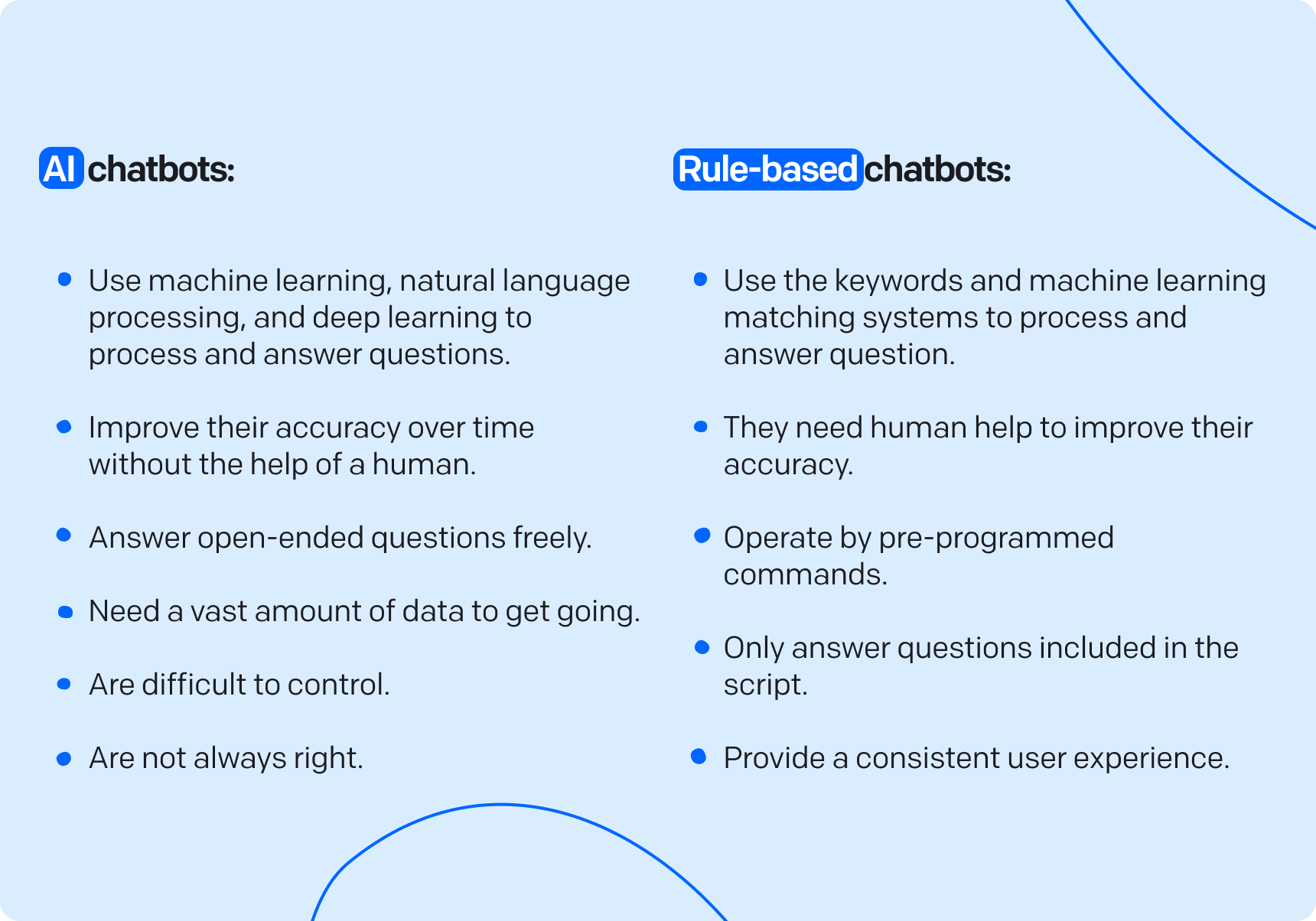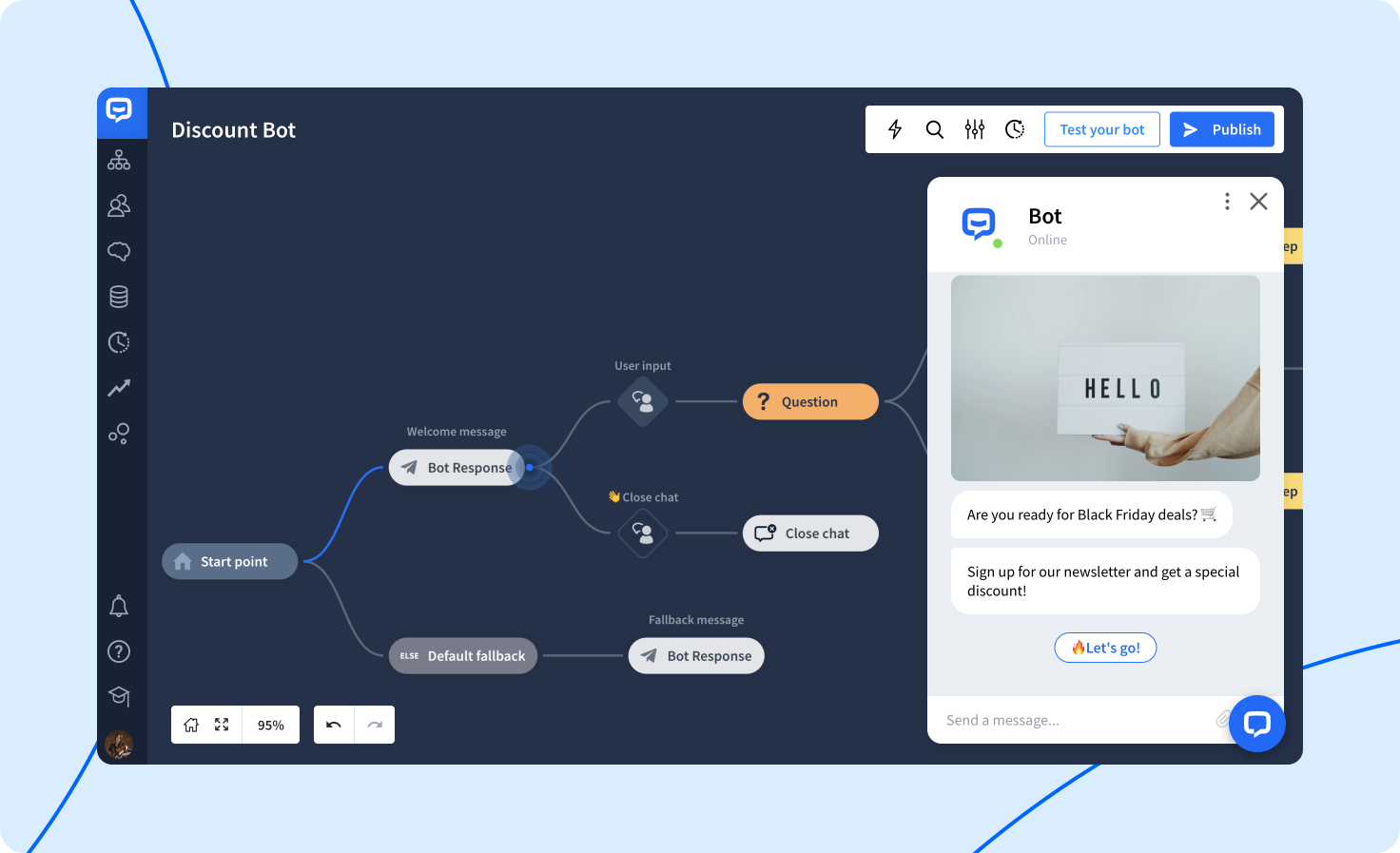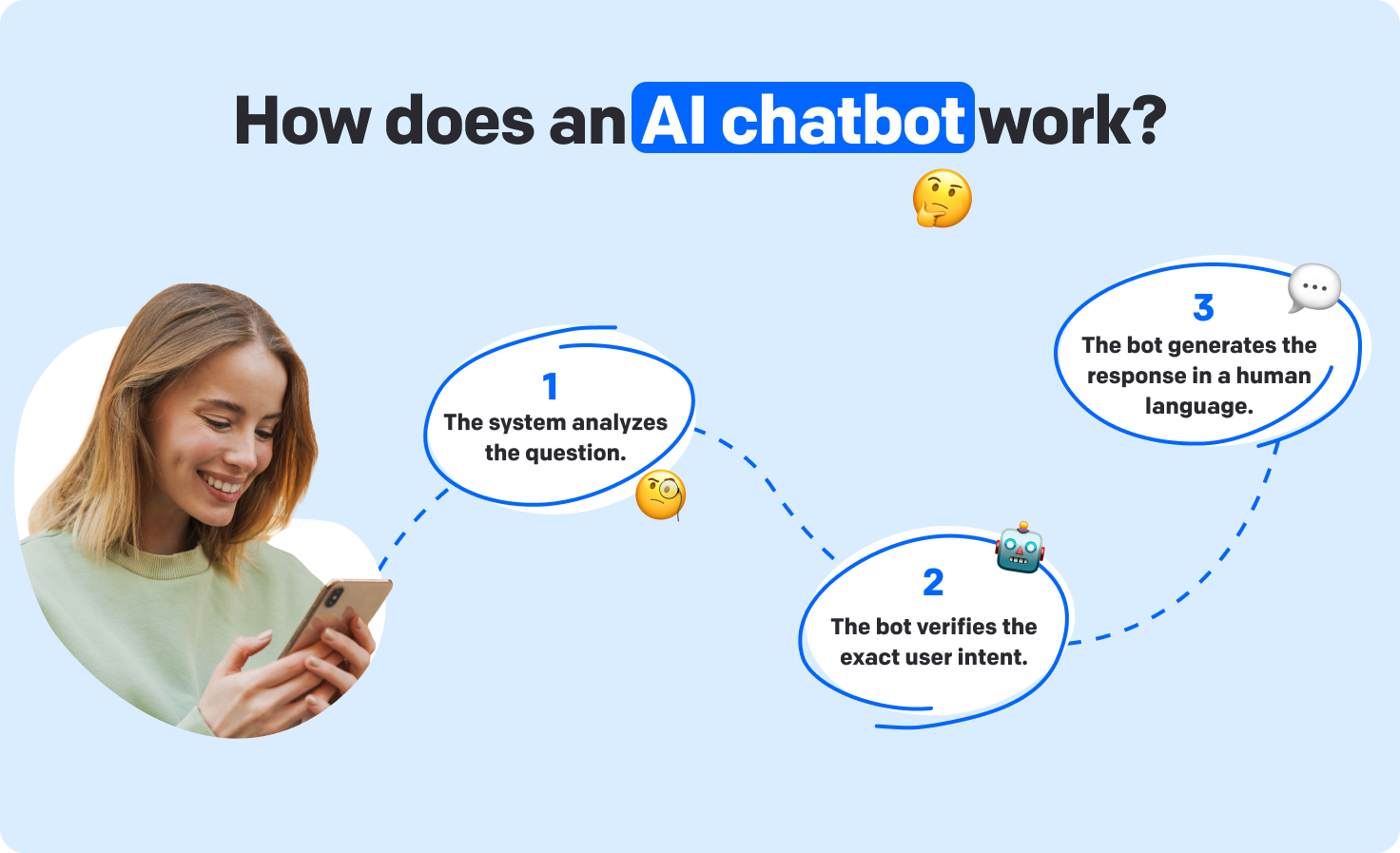

Chatbots have the potential to improve our lives in countless ways. Businesses of various sizes use them to streamline their support services and help customers via chat, no matter the time of day.
On the other hand, users can use smart assistants to solve their daily problems, such as matching the color of a new lipstick to their wardrobe, searching for a location via Google Maps, or playing their favorite song on Spotify. All of that just by using voice commands or simple clicks.
But how is it possible that seemingly unconscious computer programs can understand human language and respond accordingly? Buckle up and follow this guide to learn how different types of chatbots work from the inside.
🤖 Would you like to build your bot without coding?

To understand what the user is asking for, the bot must use technologies that let it analyze and process human languages. Then it can find out what the user wants and provide a matching response.
Generally speaking, analyzing natural language and providing answers can be done in two ways, which helped define the two main groups of chatbots: AI bots and rule-based bots.
The main thing that separates them is that AI chatbots can creatively answer multiple questions, whereas a rule-based chatbot follows a pre-written flow and can only answer questions planned in that flow.
Let’s dig deeper into how rule-based, and AI chatbots work to better understand the difference between them.

Rule-based chatbots are created by using no-code platforms and are based on rules and pre-written scripts.
You can make such a bot with very simple or more advanced rules. However, no matter how advanced the rules and scenario are, such a chatbot can only understand and answer questions included in the script. That means that a rule-based bot can’t learn independently or freely use the language.
The next question is, how does the rule-based bot answer your questions?
To provide answers in a human language, a rule-based chatbot uses predefined responses created by a human beforehand.
So, for instance, if you want to use a rule-based chatbot to instruct a human how to cook a shepherd’s pie, you first need to train it on what phrases users might use to ask for the recipe. It means you have to write down and train the bot with all the variations of the question "How to cook a shepherd's pie?”
Then, you can create the matching answer assigned to all these questions.
A scripted chatbot must use a matching system. A matching system is an algorithm that helps the bot to pair the user intent (question) with the right bot response.
While creating a rule-based bot, you can apply two matching systems — keywords and machine learning.
The matching system based on keywords is the exact-match algorithm that skims the user input for specific words only. It means that this system doesn't interpret the whole user question. It aims to match a recognized keyword with a dedicated bot answer.
For example, imagine you run an online second-hand shop, and you want to use a bot to let users browse sweaters from your offer.
If you apply the keywords matching system, you can train the bot to display your offer anytime the users write "sweaters” or a synonym like "pullovers” on the website chat.
What’s essential — when the keywords matching system is applied, it doesn’t matter whether the user writes a whole sentence ‘’Do you have sweaters,” or just types one word, “sweaters.” In this case, the system will ignore the keyword's context and focus on designated words only.
This characteristic makes the keyword matching system worthwhile while creating simple bot stories that focus on a small number of tasks, like, for instance, showing your shop’s offer.
Thanks to this system, the user can make less effort to complete their goal, as they can just write "sweaters" or select the button to see your offer.
However, sometimes one word can have different meanings. Besides, the user might ask a question that includes more keywords, or they can ask for more details in one query. In such a case, you can help the rule-based bot understand the user intent by applying the matching system based on machine learning.
The machine learning (ML) matching system is a method of data analysis that helps chatbots understand the meaning of a user’s question and its context.
Needless to say, the rule-based bot based on the ML matching system analyzes the whole user’s question, not just keywords. Then it compares it with the questions available in its database and looks for similarities. When it finds a question similar to the one the user asked, it sends the user a reply that matches that question.
The ML matching system is a good option if your bot needs to answer more complex questions concerning one topic.
For example, let’s say you have an insurance company and use the bot to educate customers about your insurance packages. The example questions the users could ask your bot might sound like this:
Do you sell travel insurance?
Do you offer car rental insurance?
Do you provide overseas animal insurance?
To understand the actual question, the bot needs more context than just the information the user is looking for insurance. In this case, analyzing the whole phrase can help the bot define the exact user intent.
The advantage of the matching system that uses machine learning is error tolerance. Even if the user makes typos or errors in the message or uses an unusual word order, the system can still match the user's question with a proper answer, provided it was included in the script.
Scripted chatbots are a good solution if you want to automate answering support and sales questions or those regarding your FAQs, recruitment processes, or appointment booking. Thanks to buttons, suggested answers, and clickable cards, rule-based chatbots, can help the user achieve their goal faster by clicking through the script.
What’s more, when integrated with LiveChat, rule-based chatbots can offer a handover to a human agent anytime the user needs the agent’s expertise. This way, rule-based assistants can work as the first line of customer support and minimize the number of repetitive tasks your team has to solve daily.
Not to mention that scripted virtual assistants give you complete control over what and how you want to communicate. Thanks to that, you can ensure that your bot provides accurate answers, doesn’t confuse the user with wrong instructions, and that its language is consistent with your brand tone and voice.
🤖 Would you like to build your bot without coding?
The more advanced conversational assistants are AI-powered chatbots such as Alexa, Google Assistant, Siri, or Chat GPT. These chatbots use AI, including machine learning algorithms and natural language processing, to analyze human language and provide human-like responses.
Before they get going, AI bots must be trained with vast amounts of data to learn the patterns and characteristics of a human language. Once they get enough information, they can start processing the user input to determine its meaning and create the proper response.
What differentiates the AI website chat from rule-based chatbots is that they are learning-based and can improve without an engineer's help.
Another undeniable advantage of natural language processing algorithms is that they understand the context of the user query, which lets them answer open-ended questions freely. Because of that, AI assistants are sometimes called generative chatbots, as they can generate unique answers based on the information they’ve been trained with.

Let's take a peek under the hood and explore the algorithms that power AI chatbots.
AI covers multiple areas, including computer science, data analytics, speech recognition, hardware engineering, language translation, linguistics, neuroscience, philosophy, psychology, and software engineering.
An NLP chatbot decomposes the user questions into more minor elements that are then transformed into structured data a computer can read, interpret, and understand. This process of breaking down the user input into pieces is called parsing.
Using natural language processing, chatbots can process complex human speech, understand context, humor, and sarcasm, and generate human-like answers. By applying natural language processing to chatbots, you can make them more accurate, let them understand the user's sentiment, and create responses that feel natural to the user.
By analyzing a massive amount of information, ML algorithms can learn how to use that data to solve tasks, make predictions, make unsupervised decisions, and answer questions without being explicitly told what to do.
Once you train the ML algorithm, it can learn from past experiences. It means that a bot that uses ML can extend its knowledge and improve its accuracy with every conversation it has with the user.
These neural networks can learn to perform tasks such as recognizing patterns in images or videos without being explicitly programmed. Deep learning models can handle highly complex and abstract tasks and can be trained with large amounts of unstructured data to generate accurate responses with minimal human intervention.
When it comes to chatbots, deep learning improves their ability to generate responses that are more relevant and natural for the user.
.png)
Building an AI chat interface is a good choice if you want to let users have human-like conversations about a wide selection of topics. They are helpful as home or phone assistants as they can help the user, for instance, cook their favorite dish by providing a recipe, instruct them on how to clean a pipe, or even order the pizza.
AI assistants are also a good bet if users want to chat with an interlocutor who understands sarcasm or metaphors and can react to them. Squarely, AI bots that use natural language processing can bring more fun than scripted bots as they mimic human language quite capably.
However, to function properly, AI bots need a vast amount of data and time to filter it. Also, they’re much more difficult to control than their rule-based counterparts as they mirror user behavior. Because of that, they might alter their communication, language, or personality over time and fail to keep the expected tone and voice while chatting.
Although AI chat engines are impressive and constantly wow users with increasing capabilities, they can’t always provide the right answers. When the AI bot is unsure, it predicts the user intent instead of asking for more info. As a result, it might come to the wrong conclusions, provide harmful instructions, and confuse the user. For that reason, most brands are still hesitant to use AI bots on a large scale as they can’t assure the consistent experience businesses strive to deliver.
Chatbots have become a popular technological novelty that generates buzz. Some AI website chats are easier to build, like rule-based chatbots, while others require advanced programming knowledge to get rolling. But no matter what type of technology stands behind them, they’re here to help both online businesses and users achieve their goals easily.
If you’re starting a chatbot adventure, you can get a leg up and launch your chatbot faster using a no-code builder.
In the next lesson
7. How to Create User-friendly Chatbot Error Messages
Find out how to recover the conversation when a misunderstanding between the user and the chatbot happens.
Watch next lessonCreate your chat bot without coding

